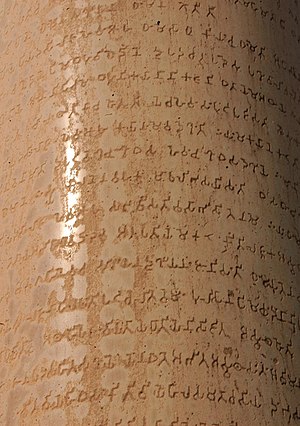Edicts of Ashoka
The Edicts of Ashoka are a collection of more than thirty inscriptions on the pillars, as well as boulders and cave walls, attributed to Emperor Ashoka of the Mauryan Empire who reigned from 268 BCE to 232 BCE.[1] Ashoka used the expression Dhaṃma Lipi ("Inscriptions of the Dharma") to describe his own Edicts.[2] These inscriptions were dispersed throughout the areas of modern-day Bangladesh, India, Nepal, Afghanistan and Pakistan, and provide the first tangible evidence of Buddhism. The edicts describe in detail Ashoka's view on dhamma, an earnest attempt to solve some of the problems that a complex society faced.[3] According to the edicts, the extent of Buddhist proselytism during this period reached as far as the Mediterranean, and many Buddhist monuments were created.
These inscriptions proclaim Ashoka's adherence to the Buddhist philosophy. The inscriptions show his efforts to develop the Buddhist dhamma throughout his kingdom. Although Buddhism as well as Gautama Buddha are mentioned, the edicts focus on social and moral precepts rather than specific religious practices or the philosophical dimension of Buddhism. These were located in public places and were meant for people to read.
In these inscriptions, Ashoka refers to himself as "Beloved of the Gods" (Devanampiya).
The inscriptions revolve around a few recurring themes: Ashoka's conversion to Buddhism, the description of his efforts to spread Buddhism, his moral and religious precepts, and his social and animal welfare program. The edicts were based on Ashoka's ideas on administration and behaviour of people towards one another and religion.
Notes
- ↑ Phuoc 2009, p. 30.
- ↑ Singh, Upinder (2008). A History of Ancient and Early Medieval India: From the Stone Age to the 12th Century. Pearson Education India. p. 351. ISBN 9788131711200.
- ↑ "The Ashokan rock edicts are a marvel of history".
| This article includes content from Edicts of Ashoka on Wikipedia (view authors). License under CC BY-SA 3.0. |
